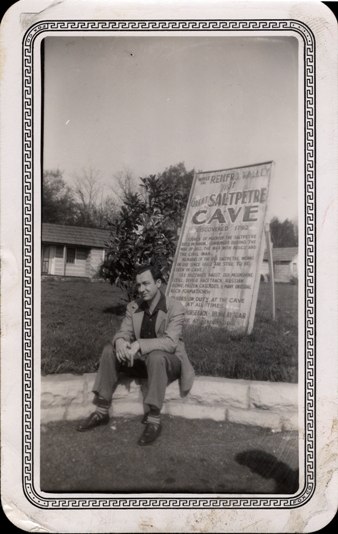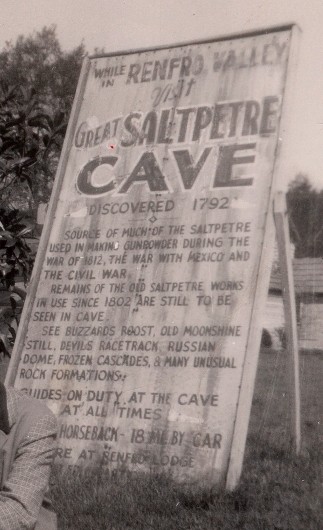

March 15, 1944
Renfro Valley Landmarks
Through a back window of the Renfro Valley Trading Post, the visitor reads the enticing invitation: "Visit the Great Saltpetre Cave, discovered 1799... Eight miles by car, sixteen miles by horseback." And immediately he is caught up by that old, primitive urge to explore, that adventurous spirit which seizes all of us at the thought of that mysterious subterranean world beneath us. Only recently has the road to Saltpetre Cave been constructed, so that now the automobile may turn off Route 25 at Livingston and in only a few minutes be at the entrance of the cave.
But the visitor reads on, "Sixteen miles by horseback." And what could be more delightful than a morning on horseback through those blue hills of hidden paths and hemlock coves? The sight of several fine saddle horses cropping grass in the pasture clinches his decision---sixteen miles it is then.
 |
 |
|
Tommy Covington at Renfro Valley - May 10, 1947 |
|
Sixteen miles of such scenery as only the Cumberlands can boast; across clear mountain streams and past cabins nestled in the atmosphere of a John Fox novel, then over the ridge and the visitor is looking down into the narrow valley of Crooked Creek, and on a hillside opposite may be discerned the cool, dark mouth of Saltpetre Cave.
It was in 1799 that a pioneer named Baker first entered this cave. After exploring a short distance, he returned to his cabin and brought his wife and three children to share in further exploration. After advancing about 500 yards, Baker dropped his pine torch and it was extinguished. For two days and nights the family wandered through the cave in total darkness, without water or food. Finally Mrs. Baker accidentally leaned against a rock and found it was wet with mud. Concluding rightly that it ought be mud they had brought in on their feet, Baker climbed the rock and there found the light of day.
Afterwards, this locality became known throughout the region as the Great Cave, and was valuable as a source of saltpetre during the Indian wars, the War of 1812, the Mexican War and throughout the Civil War. Here the earliest followers of Daniel Boone set up the wooden vats, hoppers, and other apparatus needed in carrying on that most important of early industries-the manufacture of gunpowder. Some say that Boone himself used the cave, for it is known that his companion, Stewart, was killed near the vicinity. And Boone tells in his narrative of how he was forced to live in caves when hiding from Indians.
During the War of 1812, when our government could no longer depend upon the importation of gunpowder from foreign sources, it was this cave which supplied much of that valuable necessity. The saltpetre was converted into crystals at the cave and carried out by packhorse expeditions. At first it was taken to Pittsburg to be made into gunpowder, but later the product was manufactured at Lexington, and still later a local mill was established in a locality still known as Powder Mill Holler. Some of the powder from this cave was shipped across the mountains by packhorse, floated down the Mississippi by flatboat and used by the Kentucky Riflemen in the Battle of New Orleans. Even now the remains of the crude vats, hoppers, and wooden pipes of the saltpetre industry may still be seen in the cave, although much of it was used by the natives of the Crooked Creek section a few winters ago as firewood, when the heavy snows prevented their finding fuel elsewhere. Roads were constructed through the cave over which the nitrous earth, taken from various parts of the cave, was hauled to fill the hoppers by ox-cart. Tracks of the broad-tired carts are still on the floor, and on the low parts of the ceiling may still be seen the white marks of oxen horns.
But not for its historical significance alone has the Great Saltpetre Cave became one of the greatest attractions in this section of the state. Here are the stalactites and stalagmites, the fanciful rock formations, the grottos and chambers with their romantic or grotesque names-all the beauty which typifies Kentucky's great underground world. There is the Assembly Room, where square dances and religious meetings were held up until about forty years ago. Here we come across Booger Branch, Hogpen, Old Still (the cave often served as a hideout for moonshiners and other lawbreakers of vicinity) and the Russian Dome, where the temperature is always much higher than elsewhere in the cave. In a dark grotto, we may come up on a sunken mound, which the guide tells us is the grave of a slave who was murdered here by his master.
A few years ago the cave was a popular rendezvous for the young folks of this and other sections for miles around. Sometimes several families came in wagons and "picnicked" together for three or four days at a time. It became the romantic custom for young couples to bring away a "keepsake" carved from saltpetre, which is of the consistency of soap when first cut out, but hardens when exposed to air. In many an old home in this section today may be found such an article, a heart or book carved from this substance and bearing initials and a long-past date – memento of some old couple's "courtin" days when they visited the cave together.
Even in the Law and Order reign of the present day, the story of Great Saltpetre Cave is not without drama. The visitor, riding down into the broken Crooked Creek country, may still sense the shadows of extinct moonshiners lurking in the dark coves of Crooked Creek. Not long ago these hills echoed strangely to the baying of bloodhounds hot on the scent-first demonstration to the hill people of a law other than their own "live by the gun" methods. That demonstration failed, however, and the "Mystery Case" of Crooked Creek-the bush-whack slaying of one Rosco Morris, peaceable country school teacher who was shot while mending a shed near the mouth of Saltpetre Cave-has never been solved.
Reprinted in the March 2004 Renfro Valley Bugle
Scanning and OCR work done by Andy Niekamp
Article Courtesy of Renfro Valley Entertainment Center